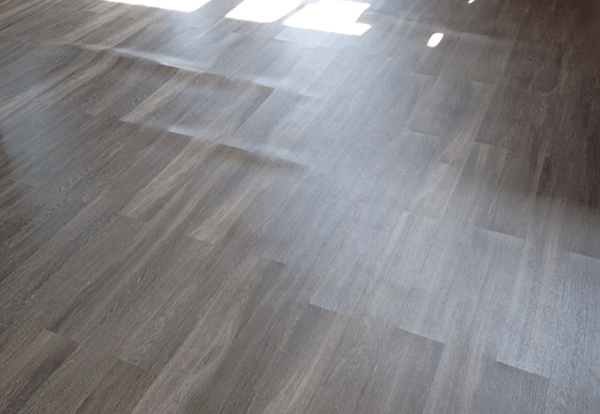Vinyl floor is one of the best floorings options to choose from. Undoubtedly, it goes easy on the bank while giving a luxurious feel to the flooring. Vinyl flooring is the best option for many reasons, including how easy it is to clean and the choices you get to choose from.
Vinyl flooring, however, has a tendency to buckle. If you’re wondering what buckling is, it’s merely the floor cramping into ripples when it faces pressure for too long. There are various installation processes for the vinyl floor, from gluing down to a loose lay process.
But the installation does not matter. If the floor installer installs the floor poorly, it will start buckling no matter what. Thus, it’s essential to have a proper installation when you get vinyl flooring.

However, if your floor is buckling despite being installed correctly, we’ll be discussing all it in our article. Hence, keep reading!
Contents
Why Is My Vinyl Plank Floor Buckling
Understanding what caused the buckling will help you refrain from buckling after the replacement of the planks is complete. There are different reasons for which your floor can buckle, and we’ll be discussing them below:
Exposure to Sunlight
Sunlight can harm your vinyl flooring immensely. Without your realization, it can cramp up the material and make it expand with heat. One of the biggest reasons for your floor to start buckling will be expanding the base during heat exposure and shrinking of the floor when it’s not exposing itself to heat. Thus, the floor will be too prone to buckling quickly.
In the summer, you’ll notice there are puffs in your vinyl flooring. However, in the winter, the floors will have a gap between them. This is the prime indication of the fact that your flooring is under the sunlight’s direct heat.
This happens because the direct sunlight heat exposure can break the bond of the glue used while placing the vinyl flooring. Fiberglass vinyl flooring users especially suffers from this issue.
However, if you have expensive vinyl flooring, there’s a specific exposure to the sunlight they can retain without buckling. Hence the heat exposure is prominently a problem in the less expensive vinyl flooring.
Humidity
If you have a humid environment in your house, your vinyl flooring subfloor may absorb the moisture from the air. This will cause the vinyl flooring to swell up.
Also, if there’s water seeping from the sides of your sliding door or windows, your subfloor may absorb the water and puff up as well.
Even if the puffing isn’t prominent, the glue bonding in the vinyl flooring base can break. Your floors will eventually start moving around, with a central buckling issue.
If you’re still amid the installation process, we recommend that you run it through a vapor barrier. The vapor barrier will help your floor from absorbing moisture, and it’ll remain dry throughout its longevity.
There are also options to go for waterproof vinyl flooring, which is the best for bathrooms. You can also use waterproof floorings in kitchens, and the rooms you feel are remarkably prone to moisture.
If you’re already facing the issue, we recommend getting a dehumidifier for your space to help the vinyl floor absorb moisture. A dehumidifier will keep your vinyl flooring intact and stop from buckling.
Packing the Floor Tiles Tightly
When you’re placing vinyl floorboards, you will have to leave some space out around the sides. No matter how optimum humidity level is inside your house, the floor will need some room to breathe.
When you walk over vinyl flooring, it has a minimal shift in its movement, which is not noticeable through naked eyes. However, if it’s not able to do the little shifting, the flooring will begin to buckle.
Make sure to leave half an inch or so spacing around the side of the boards to prevent it from buckling.
Putting extensive force over the flooring
If you have vinyl flooring that had an installation process of the loose lay process, it would be best to not put extensive pressure over the flooring. The more you put pressure, the more it’s going to buckle. This scenario is seen regularly when heavy objects are pushed around over loose-lay flooring.
We can give you the best advice for this to lift the heavy objects when shifting them. That will help take off the pressure and distribute it properly. Since vinyl flooring is less thick than most flooring, you have to remember to be gentle with it at all times.
The flooring can retain scratches easily, as well. To prevent this, you’ll want to push felt pads inside the corners of your furniture or just use thicker cotton/paper pads. This will help the floor from getting buckling around a specific point of pressures.
How to Fix Vinyl Plank Flooring Buckling
If you’re already suffering from buckling vinyl flooring, the best thing to do would be to replace the boards. If you have vinyl flooring installed through the click together or the lay-loose method, you can quickly get the boards out. The steps are described below:
- The basic procedure of replacing the plank flooring is to start with gently removing the planks. When a plank buckles, it’s easy to pluck them out. However, if your plan is glued in, you’ll want to pour mineral spirit carefully to loosen the adhesive.
- Next up, you can take the plank which has buckled and go to a store to get a cut out of the same size. You can also do this yourself with a measurement tool.
- You can easily use a rubber mallet to place the new planks. If your planks are glued in, make sure to use new and proper adhesive while placing them. You can also use a roller to level the vinyl flooring with one another.
More on LivingProofMag
Is Vinyl Flooring Toxic
Outdoor Vinyl Flooring Options for Decks
Can You Mop Vinyl Plank Flooring?
Best Mop for Vinyl Plank Floors
Robot Vacuum for Vinyl Plank Flooring
Conclusion
Vinyl floor buckling isn’t an uncommon issue in every household. You have no reason to panic as it’s easily fixable. However, prevention is better than cure. Thus, we always tip our readers to use black-out curtains to refrain from the sunlight.
Since the vinyl flooring is exceptionally durable and sturdy for residential and commercial use, we’d suggest everyone take good care of it. After prolonged usage, buckling might happen, but replacing the planks will make the flooring look as good as new.
Hence, we hope by now, you know everything there is to know about how to fix vinyl flooring buckling. Till the next time, happy flooring!
